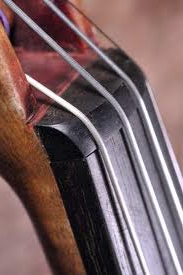Why Cello Strings Break  Why and how do new cello strings break? Mostly it is a new A string (whatever brand) and we have found that most players forget to or do not know how important it is to lubricate the string groove before installing their new strings. Usually it is the A string that will pop or break right at the nut (near the scroll) because it gets pinched or caught in the ebony nut. Why and how do new cello strings break? Mostly it is a new A string (whatever brand) and we have found that most players forget to or do not know how important it is to lubricate the string groove before installing their new strings. Usually it is the A string that will pop or break right at the nut (near the scroll) because it gets pinched or caught in the ebony nut. Take a regular sharpened pencil and work a little of the tip (graphite) into the groove slot before you put your new string on.
You should do this for every string. Not only will it help keep your string from getting pinched and keep it from breaking, it is also then easier when tuning your strings each time because then the string slides up or down much easier and will also be easy to tune. Sometimes (when the nut) is 'dry' or sticky, you will tune your cello and then after playing it, the string will pop loose just a little (going flat) while you are playing.
If you have had issues with strings breaking (and your nut and bridge are lubricated already), you should also ask your luthier to check the angle from your nut to tuning peg. Too sharp an angle can cause too much pressure on the nut slot and string. Changing the nut string groove at a softer angle will greatly alleviate this problem.
Sometimes cello strings just get old, wear out and break. So many times though new strings break way too soon and it is usually right at the scroll or bridge because the string cannot pass through freely.
So now you can play more in tune and keep your new strings from getting pinched or breaking!
|